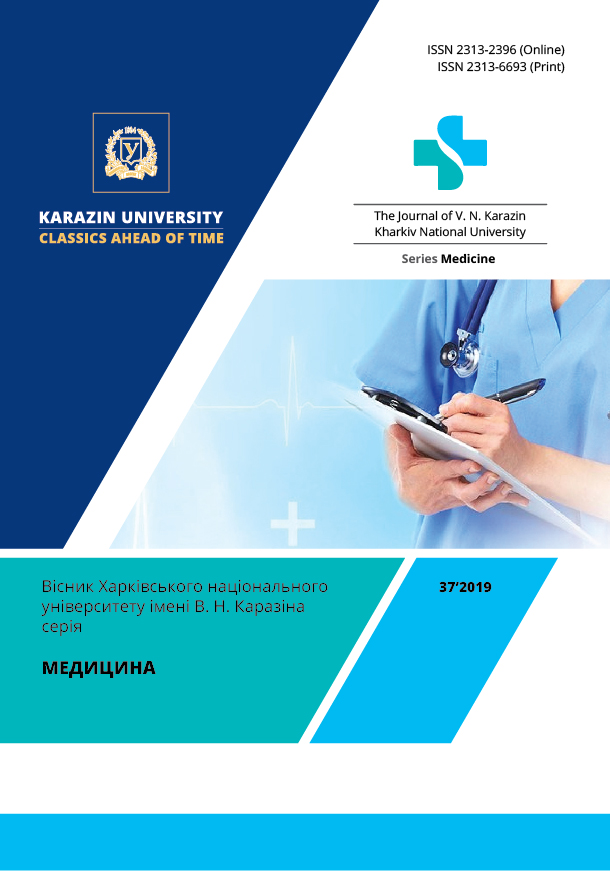Features of manifestations, treatment and prevention of nsaids – induced gastroduodenopathy in patients of different profile departments
Abstract
Introduction. Nonsteroidal anti-inflammatory drugs are the most commonly used medicines in medical practice. As literary sources show, they often cause unwanted side-effects. The purpose of our work was to evaluate the frequency, clinical manifestations and morphological features of lesions of the gastroduodenal zone that arise in patients of rheumatologic, neurological profiles and angiosurgery department during the course of treatment with nonsteroidal anti-inflammatory drugs of different groups, to trace the dependence of the frequency of manifestations of the pathology of the stomach and duodenum from simultaneous receiving two nonsteroidal anti-inflammatory drugs and their combination with glucocorticosteroids and anticoagulants. Material and methods. 73 patients who had used NSAIDs for a long time and had endoscopically confirmed medicated gastroduodenopathy. Patients were divided into 3 groups depending on the profile of the department: Group I included - 24 patients of the department of vascular surgery; Group II - 23 patients of the neurological department; Group III - 26 patients with rheumatological profile. Results. Asymptomatic clinical picture of NSAID-gastropathy was found, which did not coincide with the available endoscopic changes in the gastroduodenal tube: in 63% of cases, erosive changes in the mucous membrane were present, and stomach and duodenal ulcers were revealed in 11%. It was also found that in the group of patients receiving proton pump inhibitors, the incidence of gastroduodenopathy was reliably lower (34.2%) than in patients who did not receive them (53.4%). During this study, it was found that the use of selective non-steroidal anti-inflammatory drugs can significantly reduce the probability of developing the pathology of the gastroduodenal zone, compared with non-selective. Conclusions. The course of treatment with nonsteroidal anti-inflammatory drugs should be as short as possible and should be carried out with minimal but effective doses. Parallel prophylactic administration of proton pump inhibitors is appropriate in patients at high risk of developing erosions and ulcers in the background of treatment with these drugs.
Downloads
References
Viktorov A. P. Side effects of modern nonsteroidal anti-inflammatory drugs: problems remain // Ukrainian Medical Journal. – 2003. –№ 1 (33). – P. 79–89. [in Russian].
Dorofeev A. E., Rudenko N. N. NSAID-enterocolonopathies: lesion mechanisms and ways to prevent // Medicine and Pharmacy News. – 2015.–№ 4 (533). – P. 6–8. [in Russian].
Nasonov E. L., Karateev A. E. Gastric lesions associated with taking nonsteroidal anti-inflammatory drugs // Clinical medicine. – 2000. – № 3. – P. 4–10. [in Russian].
Sheptulin A. A. Modern possibilities of treatment and prevention of NSAID-induced gastropathy // Russian journal of gastroenterol., hepatol. And coloproctology. – 2006. – №1. – P. 15–19. [in Russian].
Svintsitsky A. S., Yaremenko O. B., Puzanova O. G., Khomchenkova N. I. Rheumatic diseases and syndromes. – K.: Book Plus, 2006. – 680 p. [in Ukrainian].
Tkach S. M. Modern possibilities of treatment and prevention of NSAIDs induced gastro-and enteropathy // Medical and Pharmacy News. – 2015. – № 3 (532). – P.6–8. [in Russian].
Paulose-Ram R., Hirsch R., Dillon C. et al. (2003) Prescription and non-prescription analgesic use among the US adul tpopulation: results from the third National Health and Nutrition Examination Survey (NHANES III). Pharmacoepidemiol. Drug Saf., 12(4): 315–326.
Lanza F. L., Chan F.K.L., Quigley E.M.M. (2009) Guidelines for prevention of NSAID-related ulcer complications. Am. J. Gastroenterol., 104: 728–738.
The Journal of V. N. Karazin Kharkiv National University, series Medicine has following copyright terms:
- Authors retain copyright and grant the journal right of first publication with the work simultaneously licensed under a Creative Commons Attribution License that allows others to share the work with an acknowledgement of the work’s authorship and initial publication in this journal.
- Authors are able to enter into separate, additional contractual arrangements for the non-exclusive distribution of the journal’s published version of the work, with an acknowledgement of its initial publication in this journal.
- Authors are permitted and encouraged to post their work online prior to and during the submission process, as it can lead to productive exchanges, as well as earlier and greater citation of published work.




